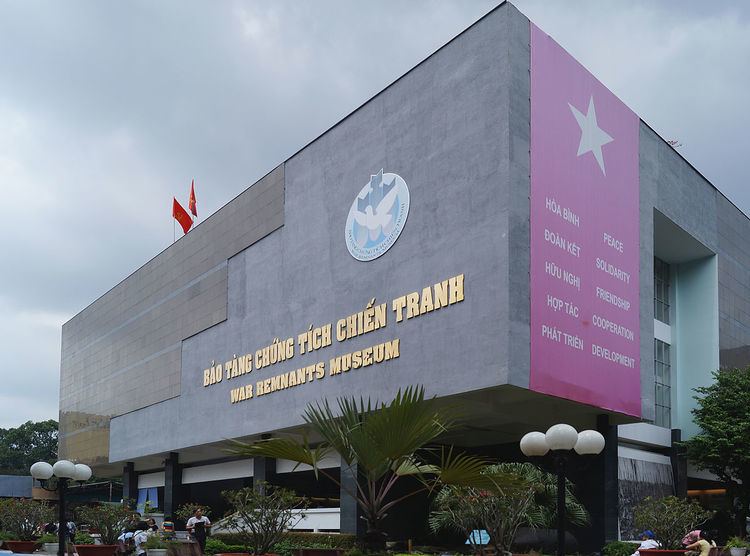Type War museum Phone +84 8 3930 6325 Established 1975 | Nearest car park no | |
 | ||
Address 28 Võ Văn Tần, 6, Quận 3, Hồ Chí Minh, Vietnam Hours Open today · 7:30AM–12PM, 1:30–5PMMonday7:30AM–12PM, 1:30–5PMTuesday7:30AM–12PM, 1:30–5PMWednesday7:30AM–12PM, 1:30–5PMThursday7:30AM–12PM, 1:30–5PMFriday7:30AM–12PM, 1:30–5PMSaturday7:30AM–12PM, 1:30–5PMSunday7:30AM–12PM, 1:30–5PMSuggest an edit Visitors approx. 500,000/year (2009) Similar Independence Palace, Saigon Notre‑Dame Basilica, Củ Chi tunnels, Municipal Theatre - Ho Chi Mi, Bến Thành Market | ||
the war remnants museum ho chi minh city
The War Remnants Museum (Vietnamese: Bảo tàng chứng tích chiến tranh) is a war museum at 28 Vo Van Tan, in District 3, Ho Chi Minh City (Saigon), Vietnam. It contains exhibits relating to the Vietnam War and the first Indochina War involving the French colonialists.
Contents
- the war remnants museum ho chi minh city
- Vietnam war remnants museum saigon ho chi minh city
- History
- Exhibits
- Reception
- References
Vietnam war remnants museum saigon ho chi minh city
History
Operated by the Vietnamese government, an earlier version of this museum opened on September 4, 1975, as the Exhibition House for US and Puppet Crimes (Vietnamese: Nhà trưng bày tội ác Mỹ-ngụy). It was located in the former United States Information Agency building. The exhibition was not the first of its kind for the North Vietnamese side, but rather followed a tradition of such exhibitions exposing war crimes, first those of the French and then those of the Americans, who had operated at in the country as early as 1954.
In 1990, the name was changed to Exhibition House for Crimes of War and Aggression (Nhà trưng bày tội ác chiến tranh xâm lược), dropping both "U.S." and "Puppet." In 1995, following the normalization of diplomatic relations with the United States and end of the US embargo a year before, the references to "war crimes" and "aggression" were dropped from the museum's title as well; it became the War Remnants Museum.
Exhibits
The museum comprises a series of themed rooms in several buildings, with period military equipment placed within a walled yard. The military equipment includes a UH-1 "Huey" helicopter, an F-5A fighter, a BLU-82 "Daisy Cutter" bomb, M48 Patton tank, an A-1 Skyraider attack bomber, and an A-37 Dragonfly attack bomber. There are a number of pieces of unexploded ordnance stored in the corner of the yard, with their charges and/or fuses removed.
One building reproduces the "tiger cages" in which the South Vietnamese government kept political prisoners. Other exhibits include graphic photography, accompanied by a short text in English, Vietnamese and Japanese, covering the effects of Agent Orange and other chemical defoliant sprays, the use of napalm and phosphorus bombs, and war atrocities such as the My Lai massacre. The photographic display includes work by Vietnam War photojournalist Bunyo Ishikawa that he donated to the museum in 1998. Curiosities include a guillotine used by the French and South Vietnamese to execute prisoners, the last time being in 1960, and three jars of preserved human fetuses allegedly deformed by exposure to dioxins and dioxin-like compounds, contained in the defoliant Agent Orange.
Reception
The War Remnants Museum is currently one of the most popular museums in Vietnam, attracting approximately half a million visitors every year. According to the museum's own estimates, about two-thirds of these are foreigners. However, visitors' opinions are mixed, ranging from favorable to "[the viewing of the exhibits] need to be taken with a grain of salt", with some going so far as to claim that the Vietnamese regime has "borrowed images from the West and inserted them into a "distorted" history", using images of the war to substantiate their version and their views on Vietnam War history.
"Although the exhibits are blatantly one-sided with many exhibits in the museum contain[ing] a heavy dose of anti-American propaganda and need to be taken with a grain of salt, they do graphically portray the horrors of war. The War Remnants Museum is worth a visit no matter your opinion on U.S. involvement in Vietnam." Another states that the museum "is unlike any museum I have seen. Most museums I have visited around the world have done well to deal with sensitive issues while presenting facts and not taking sides. ... At the War Remnants Museum however, it’s a no holds barred barrage of propaganda, overwrought with emotive language and typical propaganda buzzwords. The museum would have visitors believe without consideration, that the United States Government was evil; that American atrocities against civilians and Viet Cong soldiers were heinous and knew no bounds; and that the entire world, including the American people, were against the war. Conversely, the Viet Cong are supposed to have been kind to the soldiers they captured; they never wilfully harmed innocents; and all that the beloved leader Ho Chi Minh (or “Uncle Ho” as he is warmly referred to by the Government) wanted was peace.".
US anthropologist Christina Schwenkel wrote in a 2009 book that the exhibition is "full of propaganda", and while the description "war crimes" has been dropped from the official text, the museum still exhibits pictures that are considered controversial like that of a "smiling U.S. soldier proudly displaying a VC head as a war trophy" accompanied by a caption that is still hinting at a criminal element, in this case: "after decapitating some guerrillas, a GI enjoyed being photographed with their heads in his hands".
An analysis of the impression books (which the tourists may use to leave their comments in at the exit) revealed that the museum's visitors used to be mostly Europeans and North Americans before 2005, but that its audience became much more varied after Vietnam dropped their visa requirement for ASEAN countries that year. The impression books also record mixed responses to the museum; some visitors noted down their own anti-American sentiments, especially after 2001. Others simply praised Vietnam, while some Americans harshly criticized the museum for its "propaganda" and "glorification of [their] victory".
